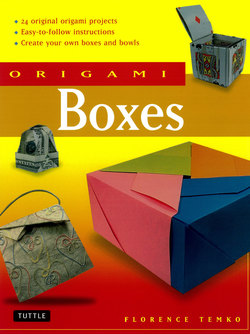Читать книгу Origami Boxes - Florence Temko - Страница 8
На сайте Литреса книга снята с продажи.
ОглавлениеAbout Origami Techniques
To help you make sense of the lines and arrows on the drawings, you should study the explanations of a few basic techniques. It will be well worth a few minutes to learn to recognize the following procedures which are international standards for origami.
Basic Procedures
1. Valley Fold
In general, you can fold paper toward you or away from you. In origami, the forward crease is called a valley fold. In the diagrams it is shown by a line of dashes.
Fold the square in half by bringing one edge of the paper toward you and matching it to the opposite edge.
You have made a valley fold.
With this one simple fold you have made a greeting card.
2. Mountain Fold
When you crease paper to the back, away from you, it's called a mountain fold. In the diagrams it is shown by a line of dashes and dots.
Fold the square in half by guiding one edge of the paper to the back and matching it to the opposite edge.
You have made a mountain fold. With this one simple fold, you have made a tent.
3. Existing Crease
A crease made previously is shown in the diagrams by a thin line that does not touch the edges.
4. Arrows
In the diagrams you will see four kinds of arrow They indicate the direction in which to fold.
Make a valley fold.
Make a mountain fold.
Double Arrow—Fold and unfold the same crease.
Curly Arrow—Turn the paper over.
5. Reverse Fold
One of the most common moves is called a reverse fold.
1. Fold a small square from corner to corner.
2. Place the paper exactly as shown. Fold the top corner over to the right, so that it peeks over the open edge.
3a. Let the paper open up, and swing the corner of the paper in between the two layers of paper on the crease you made in step 2.
3b. Close up the paper.
4. Completed reverse fold.
The instructions for making a reverse fold are indicated with a dash-dot-dash line, the same as for a mountain fold, but the text states that you must make a reverse fold.
You may wonder why this procedure is called a "reverse" fold: In step 2 you see that the doubled paper is made up of a mountain fold on the front layer and a valley fold on the back layer. After you have pushed the corner in between the two layers of paper in step 3 you have "reversed" the valley fold into a mountain fold.
About Bases
Many origami models begin with the same series of steps, which are called bases. They are recognized by paperfolders all over the world. In Origami Boxes and More, bases occur in the following models:
• Square or Preliminary Base: Desktop Basket, Star Basket
• Triangle or Waterbomb Base: Round Bowl
• Blintz Base: Classic Japanese Box, Five Happiness Bowl, Four Thirsty Birds
• Frog Base: Round Bowl
How to Cut Paper Squares
Many of the projects in this book begin with a square piece of paper. All sides are of equal length and all corners are right (90-degree) angles. Paper can be squared on a board paper cutter, if available, but it's quite easy to cut any rectangular sheet into a square:
1. Fold a short edge to a long edge.
2. Cut off the extra rectangle.
3. A square.
Sheets of 8½" x 11" copy and other printing papers can be cut into two sizes:
• With one cut, you will have squares 8½" sides.
• With two cuts, you will have two squares with 5'/2" sides.
Copy shops will usually cut a whole ream of paper for a small fee. A ream will provide five hundred 8½" squares or a thousand 5½" squares.
Helpful Tips
If you are having trouble with a step, check the following:
1. Make sure you distinguish carefully between a valley fold (dashed line) and a mountain fold (dash-dot-dash line).
